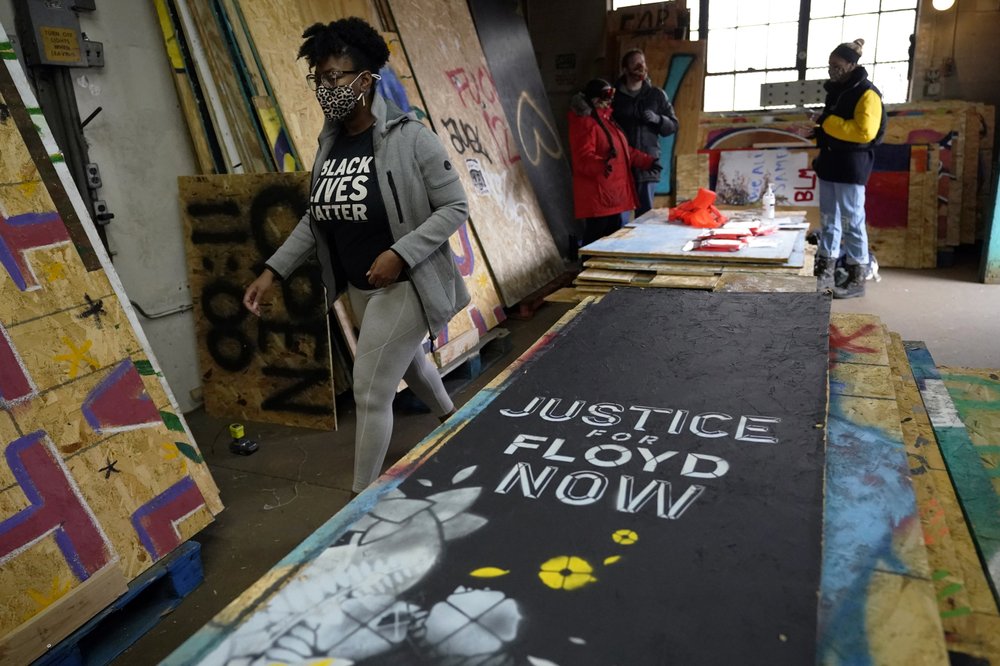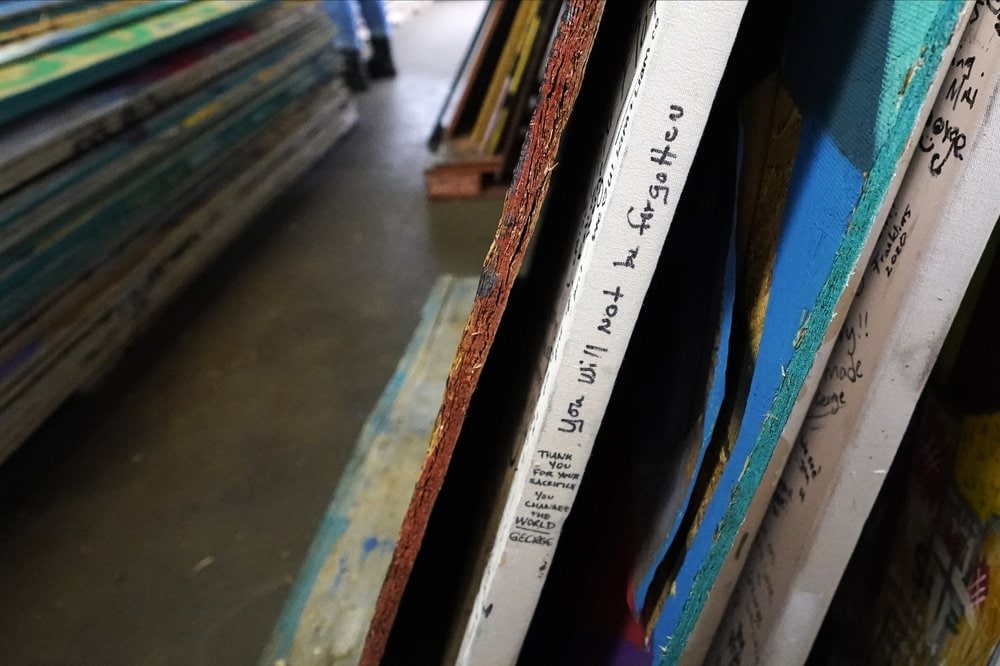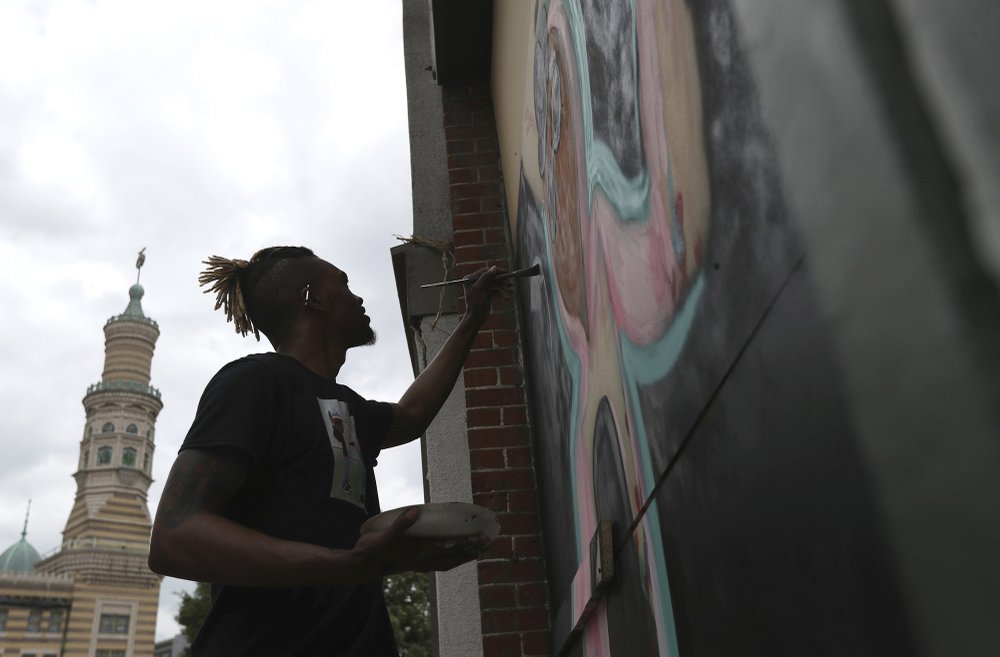Neither woman could bring themselves to watch the video of George Floyd’s final moments, his neck pinned under a Minneapolis police officer’s knee.
But as their city grieved, Leesa Kelly and Kenda Zellner-Smith found much-needed comfort in the messages of anguish and hope that appeared on boarded-up windows as residents turned miles of plywood into canvases. Now, they’re working to save those murals before they vanish.
“These walls speak,” said Zellner-Smith, who said she was too numb to cry after Floyd’s killing. “They’re the expressions of communities. We want these feelings, hopes, calls to action to live on.”
Read More: Minneapolis eyes deep police cuts after Floyd’s death
Together, the two Black women formed Save the Boards to Memorialize the Movement, part of a push to preserve the ephemeral expressions of anger and pain born of outrage over racial injustice that triggered weeks of protests across the country.
Some artists began painting intricate murals, but many spray-painted raw messages of anguish. Zellner-Smith started with the simple pieces.
“Some of these boards aren’t pretty,” she said. “There is collective pain and grief in each board, and each one tells a different aspect of this story. And now we get to tell that story to everyone.”

One is the word “MAMA” scrawled hastily onto the side of an abandoned Walmart. The word was among Floyd’s last. Now it’s part of a database of protest art called the Urban Art Mapping George Floyd and Anti-Racist Street Art database.
“The art was changing quickly, and these raw, immediate responses were being erased and painted over,” said Todd Lawrence, an associate professor of English at the University of St. Thomas in St. Paul, Minnesota, and one of the database’s creators. “We want people to see the full range of responses, the complexity, the multitude of voices.”
Lawrence and art history professor Heather Shirey were part of a research team already documenting street art. When the streets of countless cities became temporary galleries after Floyd’s death, they set out to capture the art before it disappeared.
Although many of the 1,600 artworks in the crowdsourced database come from Minneapolis, Shirey says they hope to expand to pieces from around the world.
“Oppression and racial violence is unfortunately universal, so art is responding to it around the world,” she said.
Similar work is going on across the country as groups take measures to keep the art alive.
In New York City, the Soho Broadway Initiative worked with local arts groups to get permission for murals and provide artists with materials. As murals started coming down, the organization returned 22 artworks to artists and collected 20 more waiting to be returned.
In Indianapolis, organizer Malina Jeffers is unsure about the future of the Black Lives Matter street mural stretching across Indiana Avenue. The mural is wearing down from traffic, and with winter will come weather damage and snowplows.
But the mural will live on in prints and T-shirts created by the local Black artists behind the original mural. More than 1,000 shirts have been sold. Vinyl banners representing 24 other murals painted in the downtown area are displayed at the city’s Central Library.

“All of us know the mural won’t be there forever,” Jeffers said. “So we all wanted a piece of it to hold onto.”
For Seattle’s Black Lives Matter street mural, Mexican American artist Angelina Villalobos, aka 179, mixed her mother’s ashes into the bright green paint she used for the letter A. City workers scrubbed the mural from the asphalt after it began chipping, but one worker collected paint from each letter, which Villalobos plans to keep on her mother’s altar in the kitchen.
“I’m getting my mom back, but she’s been transformed,” she said. “It’s like … a time capsule of that mural experience and all the work and thought and pain that went into it.”
The original artists have repainted the mural, planning to touch it up again in five years.
Designers at the Seattle architecture and design firm GGLO are using a different approach to preserve protest art by creating an augmented reality art show that allows visitors to use smartphones to view works scattered around the city. The show includes a digital version of the “Right to Remain” poster by local artist Kreau, 3D graffiti honoring victims of police brutality and digital tears pouring over Seattle’s skyline.
Gargi Kadoo, a member of the design team, says much of the protest art around Seattle was removed. Street art has been erased in many other cities, including Tulsa, Oklahoma, where workers in October removed a Black Lives Matter painting at the site of the Tulsa Race Massacre where in 1921 a white mob attacked a prosperous African American district, killing an estimated 300 people. Other cities such as Indianapolis and New York City have seen their Black Lives Matter murals vandalized.
“This is our homage to the art that is gone,” she said. “It’s trying to keep the message alive virtually, in a form that no one can take down or hose off.”
In Oakland, California, community arts organizations are preserving and cataloging more than 700 murals. The team is discussing plans including a December outdoor exhibition, a 2021 indoor exhibition, and high school lesson plans centering the artwork, said Jean Marie Durant, president of Oakland Art Murmur Board of Directors.
The Black-led Black Cultural Zone has a leading role in the project.

“We’ve been living this story, this trauma for a long time,” CEO Carolyn Johnson said. “That gives us a perspective that others may not have. We know how to best tell this story.”
Back in Minneapolis, Save the Boards is working with researchers Lawrence and Shirey as well as the Minnesota African American Heritage Museum and Gallery to document, archive and plan an exhibition in May 2021, the anniversary of Floyd’s death.
Museum co-founder Tina Burnside says the initiative hopes to preserve the murals in a way that continues dialogue on systemic racism, provides context and allows for public access.
“It’s an important chapter in the fight for racial justice in this country,” she said. “We’re documenting history.”
Read More: Louisville protester Kris Smith fatally shot weeks after death of BLM activist
Kelly and Zellner-Smith have filled their warehouse space to capacity. They started out by hoarding boards in their garages. Now, they have 537 in a warehouse. They say watching the space fill up was surreal.
“Being surrounded by these boards that encompass this pain and grief and hope, it was spiritual,” Kelly said.
The group’s next steps are to catalog the boards, do 3D scans and build a virtual gallery.
But while Kelly and Zellner-Smith created a GoFundMe to raise money for the project, funds have quickly dwindled.
“They all need to be saved,” Zellner-Smith said. “They all matter, and we want to keep collecting. We’re just a little stuck right now. But the work is far from over.”
Have you subscribed to theGrio’s new podcast “Dear Culture”? Download our newest episodes now!
TheGrio is now on Apple TV, Amazon Fire, and Roku. Download theGrio today!
Share









More Stories
Trump Rescinds HBCU Support: A Dismantling Of Opportunity For Our Youth – Black Enterprise
Chinese Americans in Jim Crow South represented in ‘Sinners’ – AsAmNews
Former Dem congressman suggests Shedeur Sanders fell in NFL Draft because 'America fears strong black men' – Fox News